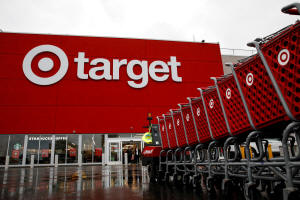|
The
company's merchandise is skewed more toward discretionary
products and it has been shifting focus to household essentials
and groceries due to sticky inflation and higher interest rates.
"Right now (the American consumer is) spending more due to
inflation, saving less and delaying major purchases," Senior
Target executive Christina Hennington said in a media call.
The company's lackluster forecast comes a day after top U.S.
home improvement chain Home Depot Inc guided a
steeper-than-expected decline in annual profit, setting up a
cautious run-up to retail behemoth Walmart's earnings on
Thursday.
Target also beat analysts' expectations for first-quarter
results. Gross margins increased to 26.3%, compared to 25.7% a
year earlier, largely helped by reduced freight costs and fewer
clearance discounts.
Quarter-end inventory was 16% lower than last year, reflecting
more than a 25% reduction in discretionary items.
"Target's original guidance for the year was on the conservative
side ... Against that backdrop, we think Target's print is a
step in the right direction," D.A. Davidson analyst Michael
Baker said.
The company's shares were marginally lower in choppy premarket
trading. They had reversed early losses to trade up as much as
2%.
MIXED BAG
The maintained forecast comes as Target benefits from steady
demand for beauty products and household essentials, as well its
private-label brands.
Even though U.S. retail sales rose less than expected in April,
the underlying trend was solid pointing to strong consumer
spending early in the second quarter even as recession worries
rise, data showed on Tuesday.
Target projected adjusted profit between $1.30 and $1.70 per
share, below estimates of $1.93 for the current quarter and
forecast comparable sales to decline in the low-single digits.
"There is still some pain points with the consumer and they are
still being cautious, which in Target's case I do think it's
extremely justified going forward," Jessica Ramirez, senior
analyst at Jane Hali and Associates.
The company also said theft and organized crime could reduce
this year's profitability by more than $500 million compared to
2022.
First-quarter comparable sales also grew by a
better-than-expected 0.7%, helped by a 0.9% increase in store
traffic, but digital sales posted a surprise drop.
(Reporting by Ananya Mariam Rajesh and Aishwarya Venugopal in
Bengaluru; Editing by Sriraj Kalluvila)
[© 2023 Thomson Reuters. All rights
reserved.]
This material may not be published,
broadcast, rewritten or redistributed.
Thompson Reuters is solely responsible for this content.

|
|




